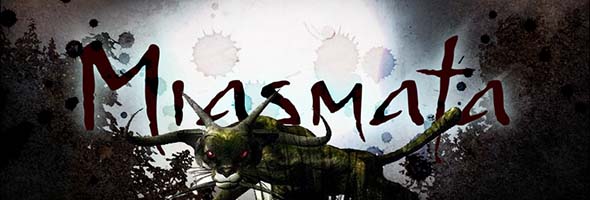
Although not a terrific game, the indie survival adventure game Miasmata (developed by Bob and Joe Johnson of IonFX) is an interesting title that does deserve to be played by its target audience. It's not a particularly challenging game, but players can back themselves up into seemingly insurmountable holes. Knowing the game's mechanics and rules - and knowing them early - is important to ensuring that you aren't forced to restart from the beginning or give up entirely.
Like with my previous strategy post for Alien Isolation, I am not going to provide specific walkthroughs for the game or any of its specific set piece challenges. In fact, doing so would be even harder than in Alien because Miasmata is a completely open-ended sandbox game. Instead, I will be offering some general-purpose tips that should be relevant for the entire game. This will include some techniques for working around the game's bugs and odd design flaws.
Owl statues point towards a cache of medicinal plants, but they do not count as landmarks or show up on the map.
This should be a pretty obvious tip. If you find the plants that are used for the 3 parts of the cure, or the three emphasis drugs, you should immediately pick them and ... [More]
12a74aef-1703-47e6-97c5-527408d0f4fe|1|5.0
Tags:Miasmata, IonFX, Bob Johnson, Joe Johnson, Steam, indie gaming, survival, action, adventure, horror, island, science, laboratory, specimen, sample, chemistry, map, compass, cartography, triangulation, torch, night, hallucination
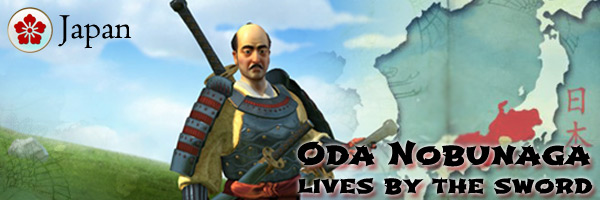
Continuing my series of strategy posts about Brave New World's modified civilizations, I'm going to take a look at strategies for Oda Nobunaga's Japan. Since Brave New World's Fall patch Japan was given additional buffs towards culture and coastal starts.
Japan is a series of four large island and numerous smaller islands that were formed by volcanoes. It has been inhabited since the upper paleolithic era (about 30 thousand years ago), and its people have lived in relative isolation for much of its history. It has gone through periods of war with its closest neighbors across the sea: China and Korea, and has had significant cultural influences from both, such native Shinto's two competing religions: Buddhism and Confucianism. Throughout most of Japanese history, the country has been in a feudal state, with regional populations being loyal to a warlord who is granted land and titles from the emperor (or "Shogun"). In-fighting between warlords was common, and power often ebbed and flowed between different clans and families.
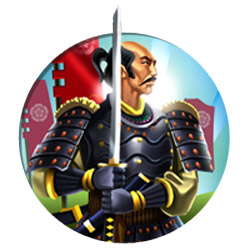
Samurai Daimyo Oda Nobunaga helped Ashikaga Yoshiaki to reclaim the title of Shogun for his clan in 1568, and Nobunaga used the leader as a puppet to enable his own conquests. He was a brutal warrior who once set fire to an enemy complex, killing tens of thousands of civilian non-combatants (including women and children) in order to put down a rebellion of farmers and monks. He eventually attained military control of more than half of the territories of Japan on behalf of the Shogun. His successor, Hashiba Hideyoshi, would complete the unification of Japan 11 years after political and personal tensions lead to Nobunaga's assassination by a vassal clan.
In the 19th century, Japan's isolation finally ended and it began the process of rapidly modernizing. By the 1930's, Japan had developed into a modern military-industrial machine that was almost the technological equivalent of the United States and European powers. It became the dominant power in the Pacific prior to being defeated by the United States in the second half of World War II. [More]
1cad9ae0-1148-4d92-80d2-cc7859222fda|3|5.0
Tags:Sid Meier's Civilization, Civilization V: Brave New World, Civilization V, Japan, Oda Nobunaga, Bushido, daimyo, shogun, Zero, culture, tourism, sea resources, fishing boats, sushi, longswordsman, fighter, warmonger, samurai, Civ V Fall Patch, Civ-V

While looking for new survival horror games on Steam, I stumbled onto a very intriguing title: Miasmata. During my holiday break from work, I decided to boot up the game and see if it scratched my survival horror itch.
It didn't, on account of not actually being a survival horror game. But what I found instead was an equally interesting premise that immediately caught my attention and piqued my curiosity.
The Johnson brothers kept this game about as simple as it could possibly be (perhaps to its detriment). They had a core concept, and they stuck to it. As such, Miasmata is a very novel game. It is probably the only game that I've ever played that is solely about scientific research.
The end goal is to cure a disease that the character has contracted and then escape the island. This disease acts as the central challenge to the game: you have to periodically medicate yourself in order to control the symptoms, but all medications must be derived from the local flora. Failure to do so can slow you down, blur your vision, and eventually kill you. A sheer majority of the game, thus, consists of wandering around the island collecting samples of plants, and then returning them to the nearest laboratory to examine them and use them to concoct various potions. In addition to medicines, you can also create potions to enhance your physical strength and perception. Doing so will allow you to run and swim further, and allow you to always know your location on the map (respectively).
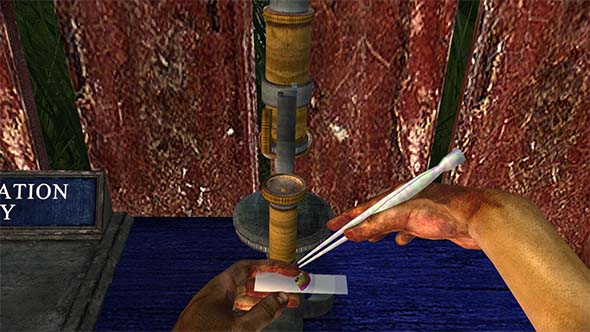
Stand back! I'm about to do SCIENCE!
Unfortunately, the process of analyzing the specimens is automated (via a skip-able cutscene). You don't actually have to do anything in order to figure out what the plant's effects are going to be, and no actual scientific knowledge is required by the player. Each plant also only has one effect, so the potion-making mechanic (which is the core of the game) is pretty shallow.
The effects of each plant will be noted in your journal, which is one of the best journal features of any game that I've ever played. It has a handy status page that includes pockets for storing your medicines, as well as holding your water flask. It also shows your objectives and has tabs to collected notes, your research results, and the map. The journal is also populated with hyperlinks that take you to the journal page with the relevant information. For example, if you find a note with ingredients for an objective drug, the status page will add a hyperlink to that note underneath the objective. It's every bit the journal that Silent Hill: Downpour wanted to have!
As you explore, you'll also find camps left behind by the deceased research team. These camps can contain notes that can reveal bits of backstory, provide recipes for various potions, or point you in the direction of key plant specimens. The camps also act as safe places for you to restock your supplies (including water), rest, and save your progress.
Keeping yourself hydrated and rested is important, as failure to do so can aggravate the symptoms of your illness and potentially kill you. Unfortunately, the feedback for this isn't terribly great. You'll get a notification when you're thirsty, but the game doesn't bother to tell you that you're tired. Instead, your health just starts rapidly deteriorating for no apparent reason. It took me a while to figure out that it was due to a lack of sleep.
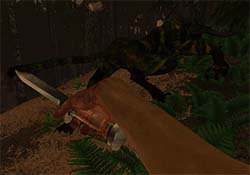
Combat mechanics are present,
but they don't have any affect.
A curious omission is that you don't have to eat. The game even includes various weapons scattered around the island, and there is an attack and throw command. But you can't attack the hostile panther-like creature that occasionally appears to hunt you, nor can you hunt and kill any of the game's various wildlife (beetles, squirrels, birds, and so forth). So you can only run and hide from the creature, and you only collect plants, which don't need to be attacked in order for specimens to be collected. So why are the weapons and attack mechanic even in the game?
Probably the second most significant mechanic is the map triangulation feature. Instead of revealing the map passively as you walk through it, the player must actively identify the location of landmarks ... [More]
d991856a-87f2-4dc9-8a5d-e20c1a004113|0|.0
Tags:Miasmata, IonFX, Bob Johnson, Joe Johnson, Steam, indie gaming, survival, action, adventure, horror, island, science, laboratory, specimen, sample, chemistry, map, compass, cartography, triangulation
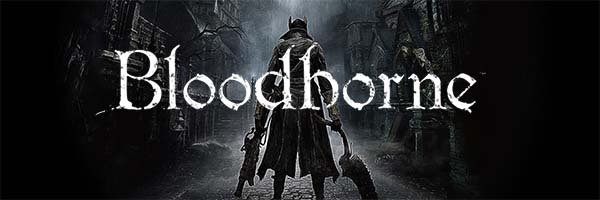
I haven't talked about Bloodborne on this blog yet, other than in passing. This has been because there wasn't much information on it except for the most superficial information and a few minutes of gameplay video. But over the past few months, more information has come out, so I'm going to take a moment to talk about some of the features and mechanics that I am excited about.
If you're not already aware, Bloodborne is the PS4's spiritual successor to FROM Software's hit games Demon's Soul and Dark Souls. Both of those games are among my favorite games on the PS3. I'm eagerly awaiting this game, as it is likely going to be the reason that I end up buying a PS4.
Overall, the game looks to play similarly to the Souls games with one major exception: it takes place in a steampunk, Victorian setting instead of a medieval fantasy universe. This means that the traditional sword and shield gameplay doesn't transfer to the new setting. In fact, shields don't seem to play a role at all. Instead, the player's off-hand can be used to equip a second bladed weapon or a gun. The lack of a shield means that the game is designed to be faster-paced, and combat is intended to be more aggressive and offensive so as to encourage players to attack and dodge rather than backpedal behind their shields.
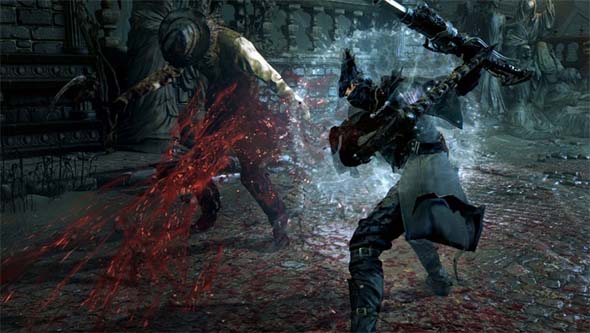
Bloodborne looks to be a darker, bloodier, and faster-paced variation of Dark Souls - with guns!.
Little is known about the game's story so far, except that it involves people transforming into vicious beasts, and the player character is hunting them. There might also be a bit of a "Dr. Jekyll and Mr. Hyde" theme here, as it's been hinted that players can transform into beasts. This is presumably a replacement for the "soul form" and "hollow form" in Demon's Souls and Dark Souls (respectively). There will be multiplayer components similar to the previous Souls games, but specific details are limited.
According to a preview at a recent Sony expo, the PS4-exclusive Bloodborne will have some interesting new features:
A demo shown in December's PlayStation Experience expo in Las Vegas, Nevada (apparently, there was an official Sony PlayStation convention in Vegas that I didn't hear about until the week after it was done?) revealed an intriguing new feature: the game will include a procedurally-generated dungeon.
The " Chalice Dungeon" (as it is called), is an optional dungeon that will vary from player to player, or character to character, or game to game, or visit to visit, or moment to moment (depending on how you interpret the tranlator). A key semantic point is that the dungeon is being called a "procedurally-generated dungeon", and not a "randomly-generated dungeon". The extent of the randomness isn't entirely clear ... [More]
c878e03d-8a1a-4f80-8e3e-4fc9eefc00c5|1|5.0
Tags:Bloodborne, From Software, PlayStation Experience, Las Vegas, Nevada, Sony, Sony Computer Entertainment, PlayStation, PlayStation 4, PSN, dungeon, procedurally generated, multiplayer, PvP, Old Monk, Demon's Souls, Dark Souls
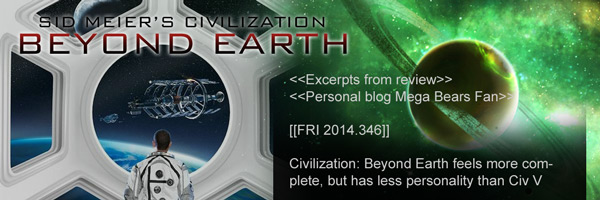
I was finishing up my Civ V: Brave New World strategies this fall, and thought that I'd finally have some time to play other games besides Civilization. Firaxis and 2K, however, had other plans. Instead of being able to play other Steam games and getting back to my PS3, instead, I now have Civ in SPACE!
I guess I can't escape Civ so easily...
So is Beyond Earth going to hold my attention, keep me up till 3 in the morning playing "one more turn", and monopolize my PC gaming? Or will it be a short diversion before being shelved in favor of other games?
Table of Contents
Most of the gameplay mechanics of Beyond Earth are variations of equivalent mechanics in Civilization V, with more or less complexity. This makes the game very accessible and familiar for most Civ players, but it also means that Beyond Earth isn't really pushing any gameplay boundaries. Whereas Civ V's transition to a hex grid revolutionized the series, Beyond Earth just feels like more of the same.
Most of the added complexity works in the game's favor, but some mechanics have been simplified such that they almost feel pointless.
Beyond Earth's extraterrestrial setting does play a small factor in the gameplay and differentiates this game a bit from Civilization V. The most prominent displays of this are in the alien life forms and the terrain of the map. The inclusions of canyons as a geography characteristic is mostly superficial, as they function almost identically to mountains. The biggest change is the inclusion of toxic "miasma". Miasma tiles cause damage to units that end their turn on it, and trade units cannot pass through miasma at all.
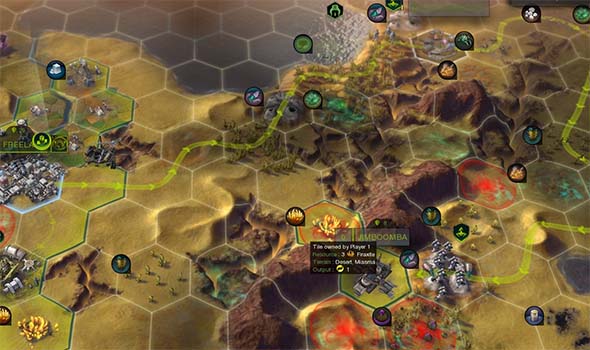
Miasma damages units and blocks trade routes until you unlock the ability to remove it or survive it.
This adds a satisfying challenge and sense of having to deal with a hostile alien environment.
This adds some challenge to the first half of the game, since miasma can force the player to explore and expand differently than they would in Civ V. Miasma can force your workers to have to avoid improving certain terrain, and may prevent explorers from accessing certain regions of the map or completing some expedition sites. It can also prevent your trade units from following direct routes between cities, which can cause them to follow winding paths far outside your inherent zone of control, making them harder to protect.
Contrary to the developers' claims prior to release, the aliens really are just reskins of Civ V's barbarians. They are counted as "enemy" units to every civilization and inflict zone of control automatically. They spawn randomly from nests that function identically to encampments, and even offer monetary rewards for entering the tile and destroying the nest. The only major difference is ... [More]
aed9db83-3047-4b4d-b015-5efe80732985|3|4.0
Tags:Sid Meier's Civilization, Civilization: Beyond Earth, review, science fiction, space, affinity, Firaxis, 2K Games, PC, Steam, strategy, grand strategy, turn-based strategy, alien, Civilization: Beyond Earth
|

| 12 | | | | | | | 60 | | 11 | | | | | | | 55 | | 10 | | | | | | | 50 | | 09 | | | | | | | 45 | | 08 | | | | | | | 40 | | 07 | | | | | | | 35 | | 06 | | | | | | | 30 | | 05 | | | | | | | 25 | | 04 | | | | | | | 20 | | 03 | | | | | | | 15 | | 02 | | | | | | | 10 | | 01 | | | | | | | 05 |
|